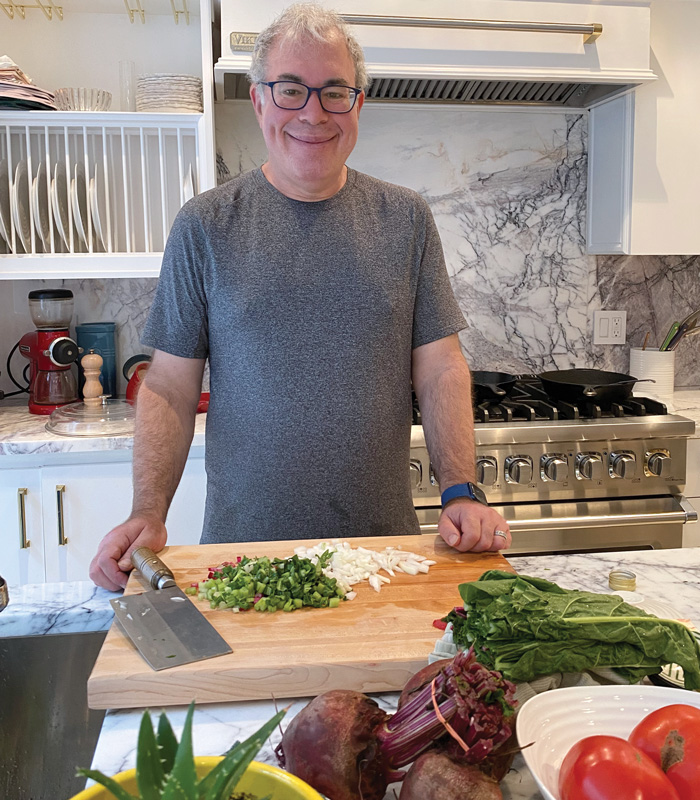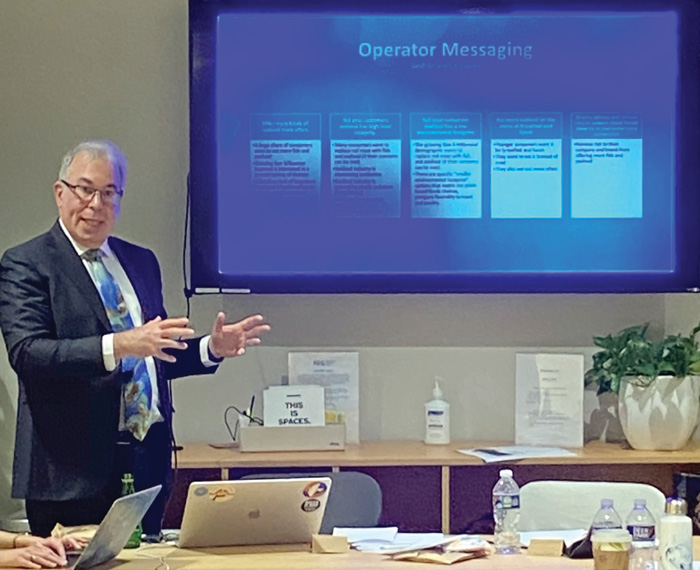
Getting Strategic About Sustainability
Long a man on a mission, Arlin Wasserman works to help food companies make good business decisions that are also good for people and planet.
Article Content
Arlin Wasserman’s passion for the food industry came naturally. His grandfather was a Russian immigrant who sold vegetables from a pushcart on the streets of Philadelphia. His father went from the grocery industry to the restaurant business to eventually owning a produce company.
Spending his first year of college in Israel at Hebrew University, however, took Wasserman’s passion for the industry in a broader direction. Working on a project digging ditches for drip irrigation and learning about the land and water issues historically at the core of Middle Eastern political conflicts sparked an interest in the larger issues around the global food chain.
Returning to the United States to complete his studies at the University of Michigan, Wasserman says he “came back to college with the mission to understand how in the modern business context we could do better.” That mission has become a lifelong passion.
His early career was spent at General Mills, where he developed the first sustainability strategy for a major U.S. food company, and at Sodexo, where he developed the first food waste training program in the foodservice industry. As the founder and managing director of the consulting firm Changing Tastes, Wasserman has helped identify and catalyze some of the most significant shifts in the way industry professionals and consumers think about food, including a leading role in the Menus of Change initiative, an education program to integrate menu design, nutrition, and sustainability. The consultancy’s client list ranges from The Walton Family Foundation to The World Bank and Chick-fil-A to The Culinary Institute of America along with many others.
Food Technology met up with Wasserman recently to gain his perspective on the business practices that will serve the food industry well in a climate of constantly changing consumer needs and concerns. The following interview has been edited for clarity and brevity.
Q: You have shunned the moniker of “food ethicist.” Why is that?
Wasserman: I’m a businessperson. I am a practical person. We don’t need a layer of professionals debating and telling us the basic stuff we learned as kids is the right thing to do. We don’t need volumes of books to say if there’s something valuable that can be reused. I’ve made my career coming up with good business ideas about food.
Q: It was 20 years ago that you developed the first sustainability strategy for General Mills. Now such a strategy is the price of admission in the food business. How have you seen the specific components necessary for a successful strategy evolve over time?
Wasserman: At General Mills we made forward-looking specific commitments on key performance indicators like pounds of carbon used to produce a pound of food. But now the game has changed. Now we are looking at the whole supply chain. Food companies can adjust beyond what they do in their own factories.
Also at General Mills, we added a couple of nutrition benchmarks because for consumers, these two things were already starting to come together. What we put in our bodies (like trans fats and added sugars) and what we do to the planet are not really siloed off into different buckets of thought for consumers the way they are in a company that may have an environmental team and a nutrition team that work in separate offices or buildings. Unfortunately, two decades later, making commitments has become commonplace, but achieving them is trickier. I’ve seen companies moving the goalposts rather than admitting failure.
The other thing that has changed is that sustainability has become a profession, which means professionals tend to change companies every few years, and that makes institutional memory brief. So no one is holding companies accountable, saying, “Hey, we are missing the mark?”
Q: So, what report card grade would you give the food manufacturing industry on sustainability?
Wasserman: I’d give the industry a “B.” Some are doing a little better, some worse. Things that can be controlled in manufacturing like energy efficiency and waste reduction inside our factories are going really well. What we're doing around packaging is a mixed bag. Using nonrenewable resources to make a single-use disposable item is just not a good practice. That said, each company is dealt the hand they play. If you're making a perishable product like smoked fish or a dairy product, your packaging choices are much different than if you're making granola or flour. There has been progress. Some companies are moving from plastic to paper. I just wish it was happening faster.
Q: What about ingredient sourcing?
Wasserman: There is a good business opportunity in improving sourcing. There's something about our climate that is making harvest less predictable. Our businesses need to not act as if it is predictable and then miss financial performance. COVID, supply chain issues, and the increase in severe weather have made it apparent that if you’re trying to make a product that relies on one ingredient and you're buying them on the commodity market, you're going to have a much harder time controlling your food costs. Pea and oat prices jumped by 50% to 100% in a matter of weeks based on harvest forecasts. If you’re locked into an ingredient, you either need to be sourcing directly from several places on the planet or you need to have a more flexible approach to your product that allows you to change the recipe based on growing conditions.
Q: You stated last November that scientific credibility is now a political issue. What does this mean for food manufacturers trying to instill trust in their products and their ingredients?
Wasserman: COVID made some marketplace changes happen faster. One is that baby boomers lost their standing as the largest demographic by spending power and numbers to millennials. This occurred because many baby boomers retired early, reducing their spending power, and because 80% of all COVID deaths have been from that generation.
Baby boomers are a generation that sought out foods that would extend their life span, like heart-healthy fats and fiber. Millennials, and closely aligned Gen Zs, are very different in their attitudes. They are not as concerned about maintaining or improving health status through conventional nutrition. They are also more skeptical of science.
For example, baby boomers are most likely to eat fish and seafood to get omega-3 and heart-healthy fats. Millennials and Gen Zs are really concerned about ingesting microplastics, mercury and other industrial pollutants, and antibiotics from farmed fish and seafood, and eat less of it, even though established science says the benefits outweigh the risks.
Q: So how does the industry address this?
Wasserman: This gets into how the industry communicates. The industry practice of sponsoring studies to find health benefits about an ingredient it likes created some confusion for baby boomers but created distress for millennials. When these consumers say they don’t want microplastics or BPA in their bodies and the industry moves to set the record straight or minimize their concerns, it ends up undermining all health and nutrition advice. A better move by some companies has been to admit that those concerns have some legitimacy, and then make improvements. An example is a decade ago when the poultry industry was saying antibiotic use wasn’t a public health threat, then Perdue figured out how to eliminate their use, and in the end the rest had to follow.
Q: You were working 20 years ago on public policy around cardiovascular health and childhood obesity. Where do you see those issues today?
Wasserman: I'm not optimistic about where policy has taken us on childhood obesity. School feeding programs are reimbursed on the number of children who actually eat the food. Serving healthier versions of pizza and nuggets has only taught children to eat less healthy versions of those foods outside of school. And the past two years of inactivity through COVID has not helped. The only move that food manufacturers can really make is to take all the kid-friendly foods and reformulate them so there's only healthier choices. But if you create and label as a healthy brand, we know that drives people away because they think they are trading off flavor.
Q: What else concerns you for childhood nutrition?
Wasserman: Osteoporosis is a childhood disease, whose symptom show up when you're older. We are building our bones into our early 20s, and around age 22 or 23, we hit our best bone matrix. So, if we are eating low-calcium foods and avoiding weight-bearing exercise when we're teenagers, or early in our 20s and we have bad bone density, it's not going to get better. One out of every two women over 55 and one out of every four men in the United States will experience a fracture after age 55 related to osteoporosis, and for many of them it will change their life.
We launched a philanthropic education program during COVID called Million Dollar Bones (milliondollarbones.com) around wellness and osteoporosis prevention. Our comment to the food industry is that this is an emerging health issue we can avoid. Food manufacturers can help by promoting calcium-rich foods, paired with a message to stand up, put some weight on your feet, walk around, jump around, dance around, and [do] not let screen time shape the rest of your adult life.
Q: What is your take on trends in the protein sector?
Wasserman: We're at a record low for the number of Americans who say they want to keep eating as much meat as they did last year and a record high of the number that want to figure out something else, but still want meat as part of their diet. So, for the last couple years, while millennials and Gen Zs say they want to eat more fish and seafood, they are afraid to (due to microplastics, antibiotics, and forced labor concerns), so what they are eating more of is chicken. Gen Zs and some millennials are also concerned about the effect of what they eat on the planet. So, the seafood industry needs to acknowledge and address these concerns. The industry also needs to understand that these generations do not cook that much, so seafoods that are smoked or cured or easy to prepare will do better.
Q: What about plant-based meat alternatives?
Wasserman: Plant-based meat alternatives consumption declined early during the COVID outbreak. People are more comfortable eating less meat and cooking up alternatives like beans at home. That is different than buying a manufactured refrigerated or frozen product. People have tried them once or twice, but they are less likely to keep buying them at the grocery store or buy them for five to 10 times the price in a restaurant. We see Beyond Meat trying to explain to investors what went wrong, and Maple Leaf is rethinking their investment.
One issue is that these products have all their flavoring built in, while a chicken piece or tofu can absorb flavors, marinades, and spices. People got tired of the same taste of these manufactured meat alternatives, plus, the entrepreneurs who created them did not focus on clean label.
Q: Because of COVID, some consumers are looking for foods with longer shelf lives, but some ingredients that extend shelf life are also at odds with clean label. What should food manufacturers do?
Wasserman: Getting a few weeks more shelf life on perishable foods is different than formulating products that can last one to two years in the warehouse or freezer. We know supply chain issues make this tricky. One thing we work with our clients on now is to figure out what share of a food product’s life they have control over. Ways to make food products last a few weeks rather than just a week are not necessarily counter to clean label. This can include delivering products frozen instead of fresh or thawed.
Also, because of this move to clean label, assess your supply chain. If you're in constant, or frequent production and your product realistically is going to need to last for just 90 days or six months before it's consumed, then do you still need to use the recipe you did when you were planning for two to three years? And can you remove some preservatives and stabilizers and take the odd loss if something doesn’t sell for a couple years, which probably means there are other problems with the product.
We are moving away from “just in time” because people are still doing a little hoarding and shopping a little less frequently, but it's not as if they are buying only once or twice a year; they are just buying once a week instead of twice a week.
Q: Back in April 2021, you said there was a lot of pent-up demand and people are going to rush back to the restaurants. A year later, new COVID variants are still keeping many out of restaurants. Has your prediction changed?
Wasserman: The environment is awful for everyone who touches a consumer right now because of COVID. That said, the National Restaurant Association in February forecast that this year restaurant sales will be a record $898 billion, which would be an all-time high and only partly driven by inflation. That is because, whenever it is safe to dine, and we are already seeing it, people flock to restaurants. Hopefully, they can staff up and purchase enough food to meet that demand. Grocery store sales are going to go down some during the spring and summer and then may pick up again in the winter or when there is another COVID variant.
Q: What do you see as the most important macrotrends for food product developers to innovate around?
Wasserman: For the next year, it is about products that are easy to serve with minimal preparation, that have a clean label, and your manufacturing lines can quickly provide to either foodservice or grocery retail on a week's notice. It doesn't mean you have to make them each week, it means that your warehousing or inventory practices allow you to quickly switch channels. Right now, you can’t predict a month or a quarter ahead in either foodservice or grocery retail. The loss of kitchen talent and the desire to stop cooking at home—especially by millennials and Gen Zs—means one set of products can serve both channels.
There is also a group of people more interested in taking control of their own health. I think we’ve seen enough early signs that if there are flavors or ingredients that are immune boosting, and you can make consumers know about that, we may see taking a flavoring like ginger and turning it into more of an ingredient. There's a lot of things that we as Americans think of as flavorings like roots and herbs that in other countries make up much larger serving sizes. Americans may be willing to eat ginger the way we do scallions.
We also think the woke moment of recognizing that America is a nation of many different ethnic origins is ready to show up more on restaurant menus and then in our food choices. Our culinary population is more diverse than the country overall. Going forward, we will see things like Filipino hot sauces or African spice rubs and other things that reflect newer entry cultures, whose food is just showing up. We know that there is a system of bringing those into the grocery store and then into the frozen food section and then into the prepared food section. Manufacturers could get ahead of that rather than wait until it's evident that that's the right move.
Q: What about the trend toward local foods in the face of supply chain issues?
Wasserman: We see that the move to local is real when it means produced and harvested or caught in the United States. That it's from within 100 miles doesn't seem as important as that it's not stuck in a shipping container out at sea for six weeks or six months. I think COVID has made us a little more aware that the food industry in the United States is very well managed compared to some other countries where we get our food.
I also think concerns about equity have made us more concerned how food workers are treated. Admitting fault can set things straight, like a chocolate industry that admits things aren't great in Africa and notes their chocolate comes from Latin America. Or saying things are not great on tuna boats out in the Pacific, but we are selling you cod. These are good ways for the food industry to say, “We understand your concerns.”
Q: What is your top advice for the food manufacturing industry?
Wasserman: My first is product flexibility so you can deliver to grocery or restaurant. My second is to really start telling the story about where your ingredients come from, because the more you can make people feel great about their food choices and feel like you're being transparent and honest, the more they're going to love your brand.
Vital Statistics
Credentials: Master’s Degrees in Natural Resources and Public Health and a Bachelor of Arts in Social Sciences, University of Michigan
Career Highlights: Vice President of Sustainability at Sodexo; Chief Administrator of Recycle Ann Arbor; Developed the first sustainability strategy for a major U.S. food company while employed at General Mills
Recognition: Food and Society Fellowship awarded by the W.K. Kellogg Foundation; First Movers Fellowship awarded for business leadership and innovation by the Aspen Institute
Appointments: Appointed by Michigan Governor Jennifer Granholm to the state’s cardiovascular health and childhood obesity task forces; Appointed by Michigan Governor John Engler to the state’s blue ribbon commission on brownfield redevelopment
Advisory Roles: Advised the U.S. Department of Agriculture and the European Union on a range of issues from investing in community food systems to global trade
LinkedIn: linkedin.com/in/arlinwasserman/















